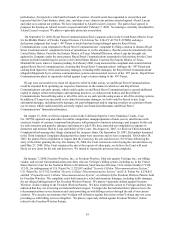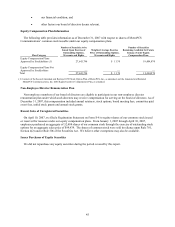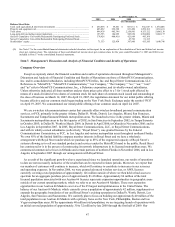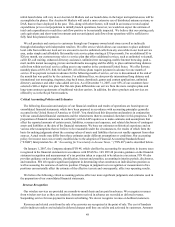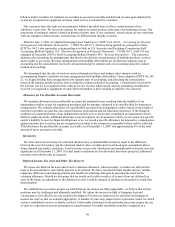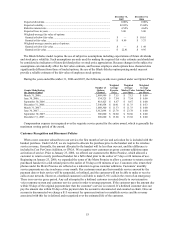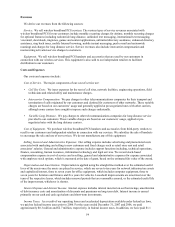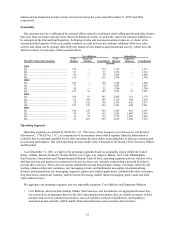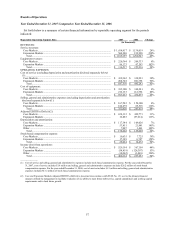Metro PCS 2007 Annual Report Download - page 59
Download and view the complete annual report
Please find page 59 of the 2007 Metro PCS annual report below. You can navigate through the pages in the report by either clicking on the pages listed below, or by using the keyword search tool below to find specific information within the annual report.48
initial launch dates will vary in our Auction 66 Markets and our launch dates in the larger metropolitan areas will be
accomplished in phases. Our Auction 66 Markets will entail a more extensive use of distributed antenna systems, or
DAS, than we have deployed in the past. This, along with other factors, will result in an increase in total capital
expenditures per covered population to initially launch operations, however, we would not expect the estimate of
total cash expenditures to reach free cash flow positive to be materially impacted. We believe that our existing cash,
cash equivalents and short-term investments and our anticipated cash flows from operations will be sufficient to
fully fund this planned expansion.
We sell products and services to customers through our Company-owned retail stores as well as indirectly
through relationships with independent retailers. We offer service which allows our customers to place unlimited
local calls from within our local service area and to receive unlimited calls from any area while in our local service
area, under simple and affordable flat monthly rate service plans starting at $30 per month. For an additional $5 to
$20 per month, our customers may select a service plan that offers additional services, such as unlimited voicemail,
caller ID, call waiting, enhanced directory assistance, unlimited text messaging, mobile Internet browsing, push e-
mail, mobile instant messaging, picture and multimedia messaging and the ability to place unlimited long distance
calls from within our local service calling area to any number in the continental United States. We offer flat-rate
monthly plans at $30, $35, $40, $45 and $50. All of these plans require payment in advance for one month of
service. If no payment is made in advance for the following month of service, service is discontinued at the end of
the month that was paid for by the customer. For additional fees, we also provide international long distance and
international text messaging, ringtones, ring back tones, downloads, games and content applications, unlimited
directory assistance and other value-added services. As of December 31, 2007, over 85% of our customers have
selected a $40 or higher rate plan. Our flat-rate plans differentiate our service from the more complex plans and
long-term contract requirements of traditional wireless carriers. In addition, the above products and services are
offered by us in the Royal Street markets.
Critical Accounting Policies and Estimates
The following discussion and analysis of our financial condition and results of operations are based upon our
consolidated financial statements, which have been prepared in accordance with accounting principles generally
accepted in the United States of America, or GAAP. You should read this discussion and analysis in conjunction
with our consolidated financial statements and the related notes thereto contained elsewhere in this prospectus. The
preparation of financial statements in conformity with GAAP requires us to make estimates and assumptions that
affect the reported amounts of certain assets, liabilities, revenues and expenses, and related disclosure of contingent
assets and liabilities at the date of the financial statements. We base our estimates on historical experience and on
various other assumptions that we believe to be reasonable under the circumstances, the results of which form the
basis for making judgments about the carrying values of assets and liabilities that are not readily apparent from other
sources. Actual results may differ from these estimates under different assumptions or conditions. Our accounting
policy for income taxes was recently modified due to the adoption of Financial Accounting Standards Board
(“FASB”) Interpretation No. 48 “Accounting for Uncertainty in Income Taxes,” (“FIN 48”) and is described below.
On January 1, 2007, the Company adopted FIN 48, which clarifies the accounting for uncertainty in income taxes
recognized in the financial statements in accordance with SFAS No. 109. FIN 48 provides guidance on the financial
statement recognition and measurement of a tax position taken or expected to be taken in a tax return. FIN 48 also
provides guidance on derecognition, classification, interest and penalties, accounting in interim periods, disclosures,
and transition. FIN 48 requires significant judgment in determining what constitutes an individual tax position as
well as assessing the outcome of each tax position. Changes in judgment as to recognition or measurement of tax
positions can materially affect the estimate of the effective tax rate and consequently, affect our operating results.
We believe the following critical accounting policies affect our more significant judgments and estimates used in
the preparation of our consolidated financial statements.
Revenue Recognition
Our wireless services are provided on a month-to-month basis and are paid in advance. We recognize revenues
from wireless services as they are rendered. Amounts received in advance are recorded as deferred revenue.
Suspending service for non-payment is known as hotlining. We do not recognize revenue on hotlined customers.
Revenues and related costs from the sale of accessories are recognized at the point of sale. The cost of handsets
sold to indirect retailers are included in deferred charges until they are sold to and activated by customers. Amounts







